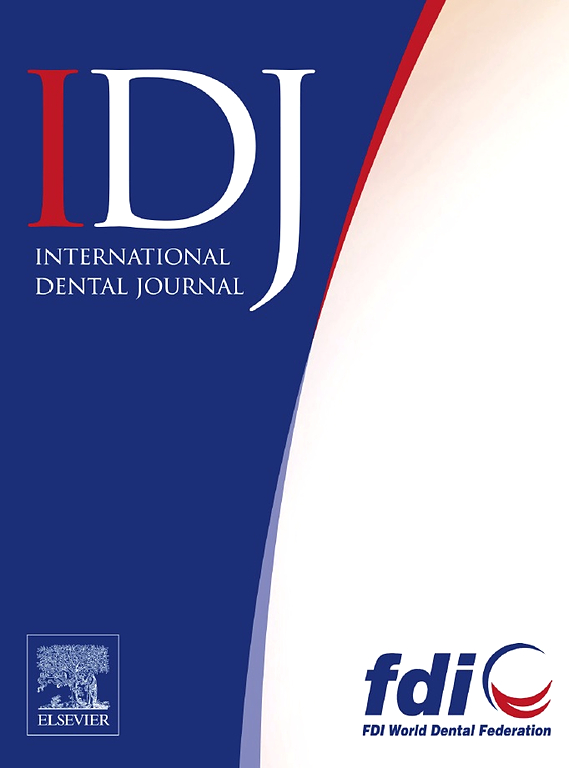Involvement of the Programmed Death 1/Programmed Death Ligand 1 Pathway in the Immune Microenvironment of Chronic Periapical Lesions
IF 3.2
3区 医学
Q1 DENTISTRY, ORAL SURGERY & MEDICINE
引用次数: 0
Abstract
Introduction and aims
This study aimed to determine the pathogenic role and clinicopathological significance of the immune microenvironment including the programmed death 1 (PD-1)/programmed death ligand 1 (PD-L1) pathway in chronic periapical lesions.
Methods
A total of 20 chronic periapical lesions consisting of 10 periapical granulomas and 10 periapical cysts were included in this study. Immunohistochemistry was performed for immune cell populations, including PD-L1, PD-1, CD4, CD8, FOXP3, and CD20. Immune cell populations were quantitatively evaluated on digitized slides. The associations between each immune cell population and clinicopathological factors and between immune cell populations were statistically analysed.
Results
Lesion size was positively associated with the density of PD-L1+ macrophages (P < .001, Fisher exact test; r = 0.455, P = .044, Pearson correlation analysis) and CD8+ cytotoxic T cells (P = .020, Fisher exact test; r = 0.471, P = .036, Pearson correlation analysis). No associations were found between immune cell populations and other clinicopathological factors, including age, sex, lesion location, and diagnosis. A moderate positive correlation was observed between the density of PD-L1+ macrophages and CD8+ cytotoxic T cells (r = 0.537, P = .015). The density of PD-1+ cells showed a strong positive correlation with the density of CD4+ helper T cells (r = 0.719, P < .001) and FOXP3+ regulatory T cells (r = 0.784, P < .001).
Conclusion
These findings suggest that cytotoxic T cells are implicated in the progression of chronic periapical lesions, which may be regulated by PD-L1+ macrophages. PD-1 may be involved in helper T cell exhaustion and regulatory T cell activity in chronic periapical lesions.
Clinical relevance
We demonstrated the involvement of PD-L1 and PD-1 in the regulation of T cell immunity in chronic periapical lesions. These findings suggest that activating the PD-1/PD-L1 pathway is a potential therapeutic strategy for chronic periapical lesions.
程序性死亡1/程序性死亡配体1通路在慢性根尖周围病变免疫微环境中的参与
本研究旨在探讨包括程序性死亡1 (PD-1)/程序性死亡配体1 (PD-L1)途径在内的免疫微环境在慢性根尖周围病变中的致病作用及临床病理意义。方法对20例慢性根尖周围病变进行分析,其中根尖周围肉芽肿10例,根尖周围囊肿10例。免疫组织化学检测免疫细胞群,包括PD-L1、PD-1、CD4、CD8、FOXP3和CD20。在数字化载玻片上定量评估免疫细胞群。统计分析各免疫细胞群与临床病理因素及免疫细胞群之间的关系。结果切片大小与PD-L1+巨噬细胞密度呈正相关(P <;.001, Fisher精确检验;r = 0.455, P = 0.044, Pearson相关分析)和CD8+细胞毒性T细胞(P = 0.020, Fisher精确检验;r = 0.471, P = 0.036, Pearson相关分析)。未发现免疫细胞群与其他临床病理因素(包括年龄、性别、病变部位和诊断)之间存在关联。PD-L1+巨噬细胞密度与CD8+细胞毒性T细胞密度呈中度正相关(r = 0.537, P = 0.015)。PD-1+细胞密度与CD4+辅助性T细胞密度呈正相关(r = 0.719, P <;.001)和FOXP3+调节性T细胞(r = 0.784, P <;措施)。结论细胞毒性T细胞参与了慢性根尖周病变的发展,并可能受PD-L1+巨噬细胞的调控。PD-1可能参与慢性根尖周围病变的辅助性T细胞衰竭和调节性T细胞活性。临床相关性我们证明了PD-L1和PD-1参与慢性根尖周围病变中T细胞免疫的调节。这些发现表明,激活PD-1/PD-L1通路是慢性根尖周围病变的一种潜在治疗策略。
本文章由计算机程序翻译,如有差异,请以英文原文为准。
求助全文
约1分钟内获得全文
求助全文
来源期刊

International dental journal
医学-牙科与口腔外科
CiteScore
4.80
自引率
6.10%
发文量
159
审稿时长
63 days
期刊介绍:
The International Dental Journal features peer-reviewed, scientific articles relevant to international oral health issues, as well as practical, informative articles aimed at clinicians.
 求助内容:
求助内容: 应助结果提醒方式:
应助结果提醒方式:


